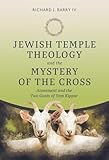Jewish temple theology and the mystery of the Cross : atonement and the two goats of Yom Kippur / Richard J. Barry IV.
Material type: TextPublisher: Washington, D.C. : The Catholic University of America Press, [2024]Copyright date: ©2024Description: xi, 420 pagine ; 24 cmContent type:
TextPublisher: Washington, D.C. : The Catholic University of America Press, [2024]Copyright date: ©2024Description: xi, 420 pagine ; 24 cmContent type: - testo (txt)
- senza mediazione (n)
- volume (nc)
- 9780813237176
- 0813237173
- BT 752.B37 2024
| Item type | Current library | Call number | Status | Barcode | |
|---|---|---|---|---|---|
 Opera (Magaz.)
Opera (Magaz.)
|
Biblioteca "Angelicum" Pont. Univ. S.Tommaso d'Aquino Temporary Library | BT 752.B37 2024 (Browse shelf(Opens below)) | Available | 0030222023 |
Bibliografia (pagine 379-402) e indice.
Introduction: Tree of Life, first and last -- Part I. The space of atonement : temple theology: Section introduction: Total immersion in sacred geography ; From Zion, perfect in beauty, God shines forth (theo-aesthetics) ; The action on the mountain stage (theo-drama) ; On Earth as in Heaven (theo-logic) ; The extremes of sacred geography -- Part II. The time of atonement : Yom Kippur: Section introduction: Learning the rhythms of atonement ; The wages of sin : a multifaceted crisis ; To heal the world : foundations for priestly soteriology ; Making all things new : Yom Kippur in Leviticus ; Yom Kippur and the mystery of the Christ : retrieving a neglected, ancient Christian theology -- Part III. Two goats, one Savior : a (modern) Yom Kippur soteriology: Section introduction: Christian Yom Kippur soteriology : a systematic outline ; The goat for the Lord in contemporary theology : David Bentley Hart ; The goat for Azazel in contemporary theology : Hans Urs von Balthasar ; The two goats and the one Lord, Jesus Christ -- Epilogue: Tree of Life, last and first.
"On the Day of Atonement, two goats were brought before the high priest at the temple. One was chosen as the goat for the Lord, a spotless sacrifice, and the other was set aside for Azazel, doomed to bear sins into the wilderness. [This book] shows how a theological appreciation for the two movements of Yom Kippur makes it possible to identify the paradox at the heart of Christian soteriology: in his single, atoning act, Jesus Christ fulfills the role of both goats, without confusion, without division. Appreciation for this paradox helps illuminate many of the doctrinal debates in the history of Christian soteriology and offers a compelling way forward".


